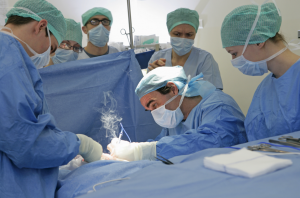Radiofrequency Ablation

In patients with chronic pain or arthritic pain, a doctor may recommend Radiofrequency Ablation. Doctors utilize Radiofrequency Ablation to reduce pain by heating up nerve tissue using electrical current. This decreases the pain signals which in turn stops the patient from feeling the pain. Typically a Spine Specialist or Physical Medicine and Rehabilitation Specialist performs this procedure.
Candidates for a Radiofrequency Ablation
Patients who have chronic neck and back pain or pain from arthritis can qualify for a Radiofrequency Ablation. In addition, patients who have had a positive Genicular Nerve Block. Depending on the cause of pain and level of pain, a Radiofrequency Ablation can relieve pain for 6 to 12 months. In some cases, pain relief can last for years.
What happens during Radiofrequency Ablation?
A doctor evaluates the patient and determines whether the patient qualifies as a candidate for Radiofrequency Ablation. Once determined appropriate, the physician performs the Radiofrequency Ablation.
Using local anesthetic and a mild sedative, the anesthesiologist places an intravenous line into the vein of the patient. This reduces the discomfort associated with the Radiofrequency Ablation. When given local anesthetic, the patient remains awake but can not feel the procedure. Using a form of x-ray called fluoroscope, the physician guides the thin needle to the target area of the spine where pain occurs. Fluoroscope allows doctors to see procedures in live time. Once in the target area, the doctor asks the  patient if they feel a tingling sensation. This helps the doctor determine whether or not they placed the electrode in the correct area for treatment. Once the doctor confirms the area of treatment, the doctor sends a radiofrequency current through the electrode into the effected tissue. The tissue heats up and that concludes the procedure. Typically a Radiofrequency Ablation takes 30-90 minutes
patient if they feel a tingling sensation. This helps the doctor determine whether or not they placed the electrode in the correct area for treatment. Once the doctor confirms the area of treatment, the doctor sends a radiofrequency current through the electrode into the effected tissue. The tissue heats up and that concludes the procedure. Typically a Radiofrequency Ablation takes 30-90 minutes
Recovery from a Radiofrequency Ablation
Following a Radiofrequency Ablation procedure, the patient can return home from the hospital on the same day of the procedure. A nurse monitors the patients pulse and blood pressure for 15 to 60 minutes to ensure stability following the procedure. A bandage gets placed over the site of the injection and a nurse reviews the discharge instructions with the patient. Due to going under local anesthetic and the nature of the procedure, the patient must have another person drive them home.
The patient must not drive or operate machinery or engage in strenuous activity for the first 24 hours following an Radiofrequency Ablation. The patient can remove bandages the same day as the procedure but cannot take a bath for two days following the procedure; The patient may shower. The patient can place ice packs on the injection site to decrease any inflammation or swelling from the procedure.

